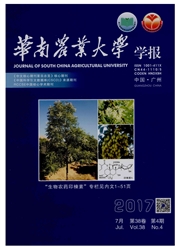

 中文摘要:
中文摘要:
以健康的草鱼为试验对象,初始体质量(50.63±0.43)g,在室内[(22±3)℃]单循环控温养殖系统中进行8周生长试验,以鱼粉为动物蛋白源,去皮豆粕为植物蛋白源,去皮豆粕分别替代0%、15%、30%、45%和60%的鱼粉蛋白,配制成5种等蛋白(W=30%)等能(15.6MJ·kg^-1)的半精制饲料,探讨大豆蛋白对草鱼生长及饲料利用的影响.结果表明,草鱼的特定生长率(SGR)各组之间差异不显著(P〉0.05);随着大豆蛋白替代水平的增加,饲料效率(FER)、蛋白质效率(PER)及蛋白质沉积率(PPV)逐渐增加,60%组开始下降,但仍显著高于对照组(P〈0.05).因此,在此试验条件下,草鱼配合饲料蛋白水平为w=30%时,大豆蛋白替代鱼粉蛋白的最适宜量为45%.最大替代量为60%.过量添加大豆蛋白,将影响草鱼的生长及饲料利用.
 英文摘要:
英文摘要:
Effects of different levels of dietary soybean protein on growth performance and feed utilization of ctenopharyngondon idellus were studied. A growth trial was conducted on juvenile fish with initial body mass of (50.63±0. 43 ) g for 8 weeks at controlled temperature (22±3 )℃ in single recireulating system. Fish meal and dehulled soybean meal were used as protein source. Five isonitrogenous (w=30% protein) and isoenergetic ( 15.6 MJ·kg^-1 ) diets, with dehulled soybean meal replacing level 0%, 15% , 30% , 45% and 60% of fish meal protein, were formulated to feed juveniles. The results indicated that there were no significant differences ( P 〉 0.05 ) among different groups in specific growth rate ; With increasing of soybean protein replacement level, feed efficiency rate, protein efficiency rate and productive protein value increased gradually, although the decreasing trend was observed when replacement level reached 60%, they were significantly (P 〈 0. 05) higher than that of the control group. It was suggested that the optimum replacement level for fish meal protein by soybean protein was 45% and maximum replacement level was 60% when the protein level of feed was 30%. Excessive soybean protein would produce negative responses on growth performance and feed utilization of Ctenopharyngondon idellus.
 同期刊论文项目
同期刊论文项目
 同项目期刊论文
同项目期刊论文
 Recombinant soybean protein beta-conglycinin alpha '-subunit expression and induced hypersensitivity
Recombinant soybean protein beta-conglycinin alpha '-subunit expression and induced hypersensitivity Development of a monoclonal antibody-based competitive ELISA for detection of beta-conglycinin, an a
Development of a monoclonal antibody-based competitive ELISA for detection of beta-conglycinin, an a Effects of glycinin on IgE-mediated increase of mast cell numbers and histamine release in the small
Effects of glycinin on IgE-mediated increase of mast cell numbers and histamine release in the small 期刊信息
期刊信息
